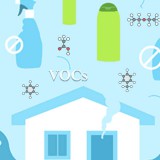The subject of this research project is the assessment of indoor air pollution in buildings due to the release of chemical compounds from the structural materials comprising them. Additionally, the study analyzes the requirements set by selected building standards and certifications regarding indoor air quality to establish concentration limits, aiming to minimize the burden on the indoor environment.
Nowadays, an increased tendency for people to remain in enclosed spaces is observed, resulting in a greater need for the design and construction of healthy indoor environments. Indoor Air Quality (IAQ) is influenced by various factors, primarily the concentration of Volatile Organic Compounds (VOCs)in enclosed environments.
In the context of this research, the goal is to analyze the concept of VOC by presenting their characteristics, the common types encountered in residences, emission sources, measurement methods, and the risks posed to occupants. Subsequently, the proposed limit values by global organizations and governments are described, including the current Greek legislation.
The next section is dedicated to certification systems, focusing on the "Low-Emitting Materials" category of LEED, which serves as a reference point for human-centric and green design, particularly in the certification related to the use of materials with low VOC emissions.
Finally, the last section provides examples of certified structural materials with low VOC emissions. This literature search seeks to the understanding of how VOC emissions from building materials affect indoor air quality and to propose choices of certified construction materials, following the specifications of applicable standards and certifications.
